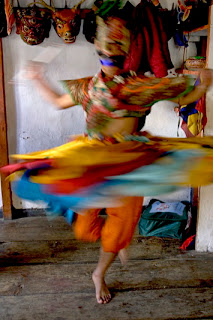
I've recently experimented with a few techniques involving motion blur, especially in dance. Whenever I photograph dances as those in Bhutan for example, I favor shooting the rapid movements of the dancers with a slow shutter speed. To me, there's some degree of trial and error until I get the right amount of blur to impart movement rather than creating an abstract image. Using one the fastest digital cameras around (Canon 1D which goes up to 8 fps) allows me to shoot a bunch of images of a whirling Tsechu dancer, capturing his movements over 10-25 seperate images....all of which will be blurry if I used a slow shutter speed.
This is useful because I can then sequence all these shots (and repeat them if necessary) on the timeline of the wonderful Soundslides (my favorite flash-based slideshow maker), and if I keep the duration of each image under a second, I obtain a moving image of the dancer's motion, similar to the well known 'flip book' technique used in animations or in cartoons. The 'flip book' concept was pioneered by many photographers, but Ed Kashi produced one on Kurdistan quite recently.
To view my 'whirling' Tsechu dancer based on the above technique, drop by my Dancing Monks of Prakhar slideshow.
Motion blur can also be achieved in post-processing in Photoshop. The tutorial is found here.
Bobbie Goodrich, whom I met on a photo tour in Bolivia, has made a name for herself by doing just that. She photographs dancers, and post processes the images in Photoshop possibly using the same procedure. Her excellent dance portfolio can be found here.
There's no question that I much prefer the real thing, however there's a little something to be said about the post processing technique, although it's not my cup of tea.
Image from Dancing Monks of Prakhar-Copyright 2006 Tewfic El-Sawy
No comments:
Post a Comment